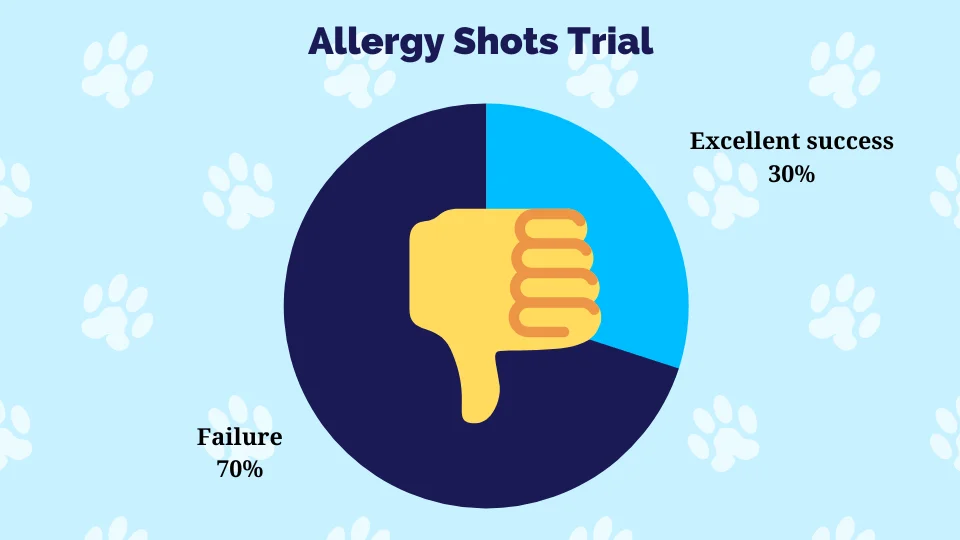By the way, this article was transcribed from our Youtube! You can watch the video instead!
Challenges of Atopic Dermatitis
As with humans, it is uncommon for us to get a lot of benefit from treating this condition in dogs with a homeopathic or natural remedy.
On the dog side, the problem with this being a genetic issue is that you cannot remove it. There is no gene therapy we have yet for dogs to change their genetic makeup. Hopefully someday… but not at this point.
So the hand we’re dealt is a diagnosis of a problem that we expect to be ongoing.
Every dog is different, every day is different, every season is different, and the severity is different. It’s a spectrum disorder. Cases range from mild to severe and sometimes the same patient will have a range. Atopic dermatitis being an ongoing problem is difficult, because there is no permanent solution to it.
There are remedies that we can use to manage the issue, but we do not have the ability to completely cure the problem.
In atopic dermatitis, your dog is inhaling their allergens. It is not contact based. They’re gonna be breathing in pollen, house dust mites, human dander, and mold. Regardless of where they live, they’re going to be inside the home breathing in pollen every single day, potentially even every single breath. They mount an inflammatory response to those things inside their body and will send that inflammation to very predictable spots.

Signs Your Pet is Struggling with Atopic Dermatitis
Where they have holes, or fake holes, you will see an inflammatory response. Again, the set of symptoms are going to vary from dog to dog, and sometimes vary from year to year as well. Perhaps there will be one year where the inflammatory response will manifest as an ear infection, and then next year, it’s going to be a skin infection, or there’s just itchiness at the paws, etc.
Symptoms you may see of this itchiness could be a pet rubbing her eyes with her front paws, rubbing her eyes along bedding, itchiness at the muzzle, shaking the head and scratching at the ears will be a secondary ear infection to the atopic dermatitis. You may even smell an odor or see inflammation.
They may try to itch their paws. They tend to lick their feet. Sometimes they bite their paws. Sometimes they corncob their lower extremities. They can itch their groin. They can be itching around their genitals as well.
If you have a male dog, scooting or licking of the anus, or a female dog, the anus and also the vulva potentially being involved as well. That’s one of the main reasons why dogs actually scoot their bottoms. It’s generally not an anal sac or anal gland issue despite that common explanation. Most of the time, it’s allergies.
They can also be itchy on the back. And if they’re itchy on their back they likely kind of do the roll around thing on the ground, or they rub their back up against the couch corner or the corner of a wall.
Treatment Options
And then we get to treatment. There’s no avoiding being exposed to allergens if your dog has atopic dermatitis. And it also is not something that you can permanently cure.
Basically, a big picture item here is probably the one thing that you absolutely must take home from this message: if you have an allergic dog, they need to stay within the guard rails every day.
So what do those guard rails look like?
Guard Rails
The first guard rail is we need to have an itch level that’s very, very low. It should be less than a 3 out of 10 on a 0 to 10 scale that you subjectively do as best you can with monitoring. There are some references online to use as a guide for when you observe your pet itching.
The second guard rail is if your pet is getting skin infections, ear infections, or both. We don’t want either of those things to exist.
When your dog is breaking out of either guard rail (or both), you need to bring your dog to the vet. If and when your dog comes to the vet, we are going to evaluate them and identify their secondary problem (the skin or ear infection) and treat it. We will also do some kind of remedy to decrease the itch, if that’s appropriate.
Occasionally we’ll have a dog come in with an ear infection that the owner says is not really an itchy dog. And in that situation, we’ll just treat the ear infection and see how things go with the itch. Occasionally, it’s the other way around: where we just have an itchy dog and no secondary problems at all. And then we’re just managing the itch. Either way, we need to do whatever it is to stay within that guard rail.
Oftentimes, that is an itch remedy of some sort, and treating the secondary problems.
We have four different options in management of this condition. Typically, at Alicia Pet Care Center, we will go in the following direction: A. Cytopoint, an injectable treatment, B. Apoquel, an immune modulating pill, C. Atopica, also an immune modulating drug, and D. Allergy testing and shots.
So let’s break those down.

Cytopoint
As I said: most of the time we will start with Cytopoint.
There’s a caveat here. If we have a dog that’s really, really inflamed when they’re coming in – they have a skin infection, they have an ear infection, and they have a lot of inflammation associated with their issue. We don’t get a lot of anti-inflammatory effects out of Cytopoint. So that may move us to Apoquel right off the bat or even cortisone as a short term thing.
Anyway, most of the time, we’re going to just try to reduce the itch. Cytopoint is that lovely tool in our toolbox for this. It is a unique treatment. It’s not technically a medication, it’s a biologic. Biologic means that it’s an antibody against something.
This particular one is an antibody against Interleukin 31. Interleukin 31 is a small speck of the immune system. And you can think of it as the itch protein. So if you take a normal dog, and you give them a bunch of Interleukin 31, suddenly, they’re going to be massively itchy right off the bat.
But it’s also not so simple that we can blame it all on Interleukin 31.
That’s part of the reason why we don’t have a 100% success rate with that treatment. But success rates are about 80%.
If your dog came in and she’s a 5 out of 10 on the scale, and we give a Cytopoint today, within 2 to 3 days, typically that itch level will come down close to 0 and stay like that for an entire month. But it doesn’t last forever.
What’s happening here is we’re painting that Interleukin 31 for removal. The immune system actually takes it out of the system, but the body is constantly producing it. So it comes back online and that’s why the injections typically only last for 1 to 2 months.
Thus, we may have to do a Cyptopoint injection again.
Back to the guard rail concept. If you are doing Cytopoint, and you get a good response (so we’re nearly 0 itch for 30 or 60 days out) then you are monitoring for when that itch level starts again. Again, it’s that point of 3 out of 10 that you want to start contacting us.
Cytopoint is a simple technician appointment here, and they are about a 10 minute appointment.
Cytopoint, as I mentioned, has an 80% success rate, or a 20% failure rate.
Failure can look lots of different ways: it doesn’t work at all, doesn’t work fast enough, doesn’t work well enough, or doesn’t last long enough. Then that very inflamed dog is also not going to get a lot of anti-inflammatory benefits out of the Cytopoint. We don’t really have concerns about side effects or drug interactions with this treatment. It’s very, very clean.
Apoquel
Our second option, if we didn’t have great results with Cytopoint, is Apoquel. Apoquel is a very well tolerated medication that a lot of doctors use across the country, with about a 70% success rate on maintenance dosing.
Usually every dog gets better the first 2 weeks because we’re generally giving them a higher dose for the first 2 weeks. And then after that, when we move to once a day dosing, it typically falls back to about a 70% success rate.
Sometimes Apoquel is combined with Cytopoint. If we have a situation where we have some degree of improvement with both of those treatments, we can combine them together without any negative consequence. But Apoquel is relatively simple.
We don’t have a lot of concerns about long term side effects. When Apoquel first launched about 13-14 years ago we did have concerns – that it would have impacted the immune system’s ability to function, or maybe an increase in cancer risk for dogs, but that is not something we have seen play out.
We’ve been really carefully watching this, not just “us” at Alicia Pet Care Center, but everybody across the country has been waiting for these adverse reactions and they have not materialized in a significant way. Suffice it to say: this is a very well tolerated medication.
Atopica
The third option is Atopica. At Alicia Pet Care Center, if you find yourself using Atopica, that means Cytopoint has already failed; maybe a food trial didn’t work, Apoquel isn’t working, alternative solutions aren’t working. So now we use another tool in the toolbox.
Atopica is a very good medication, actually. It works very well. We have a relatively high success rate with it. It was the only game in town before Apoquel and Cytopoint showed up. We had 7 to 10 years of only Atopica as a treatment option. (I have a lot of cases under my belt, because I’m kind of old now as a veterinarian.)
There are some known side effects associated with Atopica. I’ll go into them briefly here.
One negative consequence of using Atopica is that it has a very long halflife. This means it takes a very long time to build up in the system to actually be helpful for the individual patient. That usually ends up being about 6 to 8 weeks of consistent therapy before you’re going to see the results. This is unlike Apoquel or Cytopoint, where we’re going to see the results within 2 to 3 days.
There’s no short term benefit of Atopica and it’s really just a long term drug.
Additionally, if it’s dosed the way the manufacturer recommends, which is on an empty stomach, you have probably a 50% chance of vomiting associated with many of the initial doses for the first 3 weeks or so.
We recommend about 45 minutes after a meal, and it will cut vomiting risk down to about 5%. The reason why the vomiting happens in the first 3 weeks or so, is because the carrier of the medication in the capsule is an oil. It’s kind of like castor oil (if you’ve got an old enough person, they can tell you about how castor oil works). It’s very irritating in the stomach. It causes nausea… it’s a gastric irritant.
If you were to take castor oil on a daily basis, your stomach would get used to that and the vomiting would just stop happening. It’s the same way with Atopica. Usually after about 3 weeks, if there was nausea going on, that nausea just magically goes away and doesn’t come back and we never have to worry about that.
We’re kind of beyond that nausea phase when we are 4 or 5 weeks out on the initiation of the treatment. We do see that there’s a chance of having soft stool or even intermittent diarrhea with that drug that can be ongoing.
There’s also a 30% to 40% risk factor for your dog to develop excessive gum tissue growth. This is called Gingival Hyperplasia, which sounds very scary, but it’s a relatively mild side effect. It usually doesn’t cause dogs to have any clinical problems. It truly just means they have excessive gum tissue growth. Occasionally that becomes an issue that we will address under an anesthetic dental, and just cut some of that gum tissue back.
I think probably every animal hospital has a very small number of Atopica patients that are in their practice group.
Allergy Testing & Shots
And then allergy testing and shots. It’s kind of an interesting thing, but we just don’t have a lot of great success cases out there. They do exist, but most everybody is going to do allergy testing with a blood test.
You can do an actual skin test where you’re injecting the allergens underneath the skin, which is really a dermatologist thing. So, we’ll talk about the non dermatologist world.
Most everybody does serum testing, which is a blood test. The blood is drawn, sent off to the lab, and then they do a series of tests associated with that blood to give us different allergens that we know the pet is allergic to.
That doesn’t change anything.
Just knowing what the allergy is due to has no benefit. You’re not going to be able to avoid breathing in eucalyptus or sage or ragweed, whatever the issue is, because there’s nothing you can do about your environment, unless there’s a wool allergy, and you can take wool out of your house.
But even that’s probably just going to be one of several allergens.
What it allows for us to do actually is desensitize the dog using hyposensitization therapy. Basically, we’re going to trick the immune system by giving a very, very tiny amount of what the allergy is due to, and gradually increasing that amount.
The immune system initially doesn’t care about the two specks of sage introduced, and then the next time that there’s an injection with 4 specks of it, and then 8, and then 16, and so on and so forth. Gradually, the immune system just gets basically kind of lulled into complacency, and no longer mounts an inflammatory response against those individual allergens.
That’s how it’s supposed to work.
At the end of the day, with a one year commitment to doing this, (because we sometimes have cases that will not improve until close to that one year mark), we have about a 30%, excellent success group. We have a 20% group that’s meh, so there’s a little bit of help, but not so much that we can avoid doing other treatments. And we have 50% with no benefit.
So in our mind, we’re really looking at it like a 70% failure group and a 30% success group. Generally, that just doesn’t meet the mark and with our veterinarians being a pragmatic, results-oriented group at Alicia Pet Care Center, we’re going to choose something that’s going to get you results much faster than that, or more reliably than that.

So, those are the treatments.
Generally, it’s going to be Cytopoint, and cleaning up the skin infection/ear infection situation. You can learn more about our treatments for ear infections and skin infections here.
This is a complicated issue, as you see. But I wanted to just end with a discussion about one of my allergy patients that is a great example of the work you need to do for allergy patients.

Case Study
Molly is a little West Highland White Terrier, and she is a dog that’s had itchiness to some extent for a couple of years and the owners didn’t entirely understand what they were seeing.
Molly would do the classic signs of itchy behavior like licking her paws, but they thought that it was a kind of grooming behavior that they were seeing (see our article here on the myths behind licking paws).
Eventually, Molly came in and we did a physical exam. We see the white fur with rust colored paws – that was because she was excessively licking her feet. She happened to have an ear infection at that time, so we had a conversation with her owners about the allergy issues.
They were shocked and somewhat embarrassed that they hadn’t really recognized Molly’s itch behavior that had been playing out for many months.
We treated her ear infection and got that under control, and we gave her some anti-itch medication, which actually worked, initially. However, sometimes the way it works with Cytopoint is that it doesn’t work forever. Sometimes what happens there is that the dogs develop an antibody to the antibody, and then the antibody doesn’t work anymore because the dog’s own immune system is kind of attacking that antibody. So for this dog after about 6 months, Cytopoint just stopped working.
Before she started our next round of treatment (which would be Apoquel) her parents tried to use various bathing techniques and putting coconut oil on the paws; they had tried an omega 3 fatty acid supplement and all those techniques combined maybe improved things about 3%.
We put her on a high strength omega 3 fatty acid supplement that is a green-lipped mussel oil called Moxxor, which did help significantly, but not enough to allow for her to avoid going on an actual pharmaceutical.
In that situation, we went to Apoquel and Apoquel was a much better response for Molly long term. We were able to get her successfully onto a maintenance regime of once a day Apoquel. So again, Apoquel is this dog’s friend, and we have not had ear infections recur on her.
She’s been on Apoquel for over a year and has been doing really, really well and hasn’t come back with ear infections. So we’re going to take that as a win. Pet Parents are really happy with how things are going, Molly is tolerating the Apoquel while it’s working.
Conclusion
So hopefully all of this is something that you can understand – all of this very complicated information – but this is a really common issue.
Just remember the overarching concept here of the guard rail: we need to have the itch level to be very, very low, less than a 3 out of 10. If it’s above a 3 out of 10, you should be advocating for your dog to get some kind of itch mitigation or itch relief, one way or the other; whether that’s Cytopoint or Apoquel, or even a short term cortisone situation.
And then the other guard rail is skin infections, or ear infections or both.
And hopefully, with all this information, you’re now armed. As the pet parent, your role is to observe and report. Leave it to the professionals to give you guidance and help and advocate for your pet’s own well being by trying to recognize that this is a long term problem that’s happening to some extent, every single day and does probably need a long term solution.
We can’t solve a genetic problem with one treatment. It’s very expected for you to use a medication and if you stop using the medication, the problem is going to come back because the medicine is managing the problem, not curing the patient.
So that’s really important for you to recognize: it really does probably require ongoing treatment to manage the vast majority of our allergic dogs.
Book an Appointment at Alicia Pet Care Center by calling 949-768-1313. We are a family-owned, full service animal hospital in Mission Viejo, CA and have 9 doctors who can help you with managing your pet’s allergies.
About The Author
Matthew Wheaton, DVM, Chief of Staff Alicia Pet Care Center|
Matthew Wheaton, DVM has been practicing Veterinary Medicine for over 25 years. Vet Med runs in his veins; his father was also a well respected Vet in Orange County for 30 years. Matthew Wheaton graduated from vet school at UC Davis in 1996 and quickly started a career in emergency care before purchasing Alicia Pet Clinic in the summer of 2000. He has turned the hospital into the state-of-the-art, 9 doctor veterinary facility that it is today. He also has 3 pets at home, and 3 human children!
You can read his full bio here.


Recent Comments